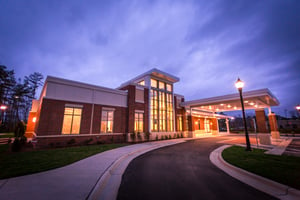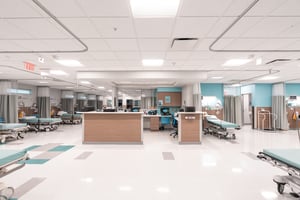Designing an ambulatory healthcare facility involves numerous decisions that impact patient and...
Pros & Cons of Super Efficient ASC Layouts
In the world of healthcare, efficiency is often seen as a virtue. This is especially true in ambulatory surgery centers (ASCs), where the goal is to provide high-quality care in a cost-effective manner. One way to achieve this goal is to design an ASC with a highly efficient layout. In this blog post, we'll explore the benefits and drawbacks of creating super efficient floor plans and discuss approaches for achieving an effective balance.
Pros of Super Efficient ASC Layouts
- Reduced footsteps and operational efficiencies: A well-designed layout can minimize the amount of time and effort that staff spend walking between different areas of the ASC. This can lead to improved efficiency and productivity.
- Accessibility: A more compact layout can reduce the amount of walking that patients have to do, which can be beneficial for patients with mobility restrictions.
- Reduced staff size: A more efficient layout may allow an ASC to operate with a smaller staff, which can save money on labor costs. An example of this, which is common in surgery centers, is a combined pre-op/PACU where the same staff can tend to pre and post-operative patients.
- Enhanced flow: A well-designed layout can improve the flow of patients and providers through the ASC. This can lead to a better patient experience and improved quality of care.
- Lower Lease or Construction Costs: A very efficient layout makes the best use of space resulting in a smaller building footprint. This can reduce lease, property, and construction costs.
- Improved energy use and operating costs: A smaller, more compact ASC should use less energy for heating, cooling, and lighting, all of which contribute to lower operating costs.
- Reduced carbon footprint: A more energy-efficient ASC will have a smaller carbon footprint, which is good for the environment.
Cons of Super Efficient ASC Layouts
- Insufficient storage: An extremely tight floor plan often sacrifices storage space for other required functions. The lack of dedicated space for supplies and equipment can lead to clutter and inefficiency.
- Equipment scatter: Parking for equipment in ORs and scrub corridors may be compromised in a super efficient layout. This is especially true in a multi-specialty ASC and can lead to congestion and safety concerns.
- Difficulty accommodating additional staff: As the surgical volume grows, it may be difficult to find space for additional staff.
- OR flexibility: Tighter ORs may make it difficult to introduce new specialties or add more complicated cases. Introducing new equipment and adding staff in the OR may pose challenges.
- Compromised clearances and circulation: Maneuvering clearances may be compromised in a condensed floorplan. While code minimum clearances must be provided, the minimums are not always enough in some areas of a busy ASC. Patient, public, and provider circulation may overlap more than desired which may introduce concerns related to privacy, safety, and infection control.
- Higher construction cost per square foot: While a smaller ASC may be less expensive to build overall, the price per square foot of construction may be higher. A smaller ASC with the same number of OR's as a somewhat larger ASC will need all of the same major systems. The opportunity cost for both will be similar, within reason, regardless of the size and economies of scale can be realized when adding space.
Achieving Balance in Planning an ASC
- Rightsizing: ASCs should conduct careful analyses of their needs to inform design and planning. This starts with diligent projecting of surgical volumes and planning for an appropriate number of OR's and procedure rooms. Projecting fulltime and part time staffing numbers and considering future staffing needs are also important. During planning, a patient throughput analysis should be conducted which will help with sizing spaces and determining the optimum number of pre-op and recovery stations. OR and central sterile layout studies depicting actual equipment and personnel in multiple scenarios is also helpful.
- Planning for expansion: While it is hard to predict whether future expansion will be necessary, it is important to consider such strategies when designing a super efficient ASC to avoid suppressing potential for future growth. Strategies may include expansion into adjacent spaces, building additions, or reconfiguring space within the existing footprint.
- Planning for future needs and innovations: Each ASC experiences a ramp up period, like any business, and visualizing and planning for future needs is a must. In addition, the evolution of ambulatory healthcare is accelerating and planners should anticipate the potential impacts of incorporating future innovations, such as robotics, augmented reality, and other new surgical technologies.
Super efficient ASC plans have many benefits. They may be necessary to getting the doors open and making your ASC a reality, but they also come with some potential drawbacks. Those planning ASCs may wish to weigh the pros and cons and seek the balance appropriate for their facility to assure it will meet your needs now and well into the future.
Hardaway|Sziabowski Architects has specialized in ASC design for over 40 years (https://www.hsarchitecture.com/work-ambulatory). Call us if we can help you sort out the needs for your center.



